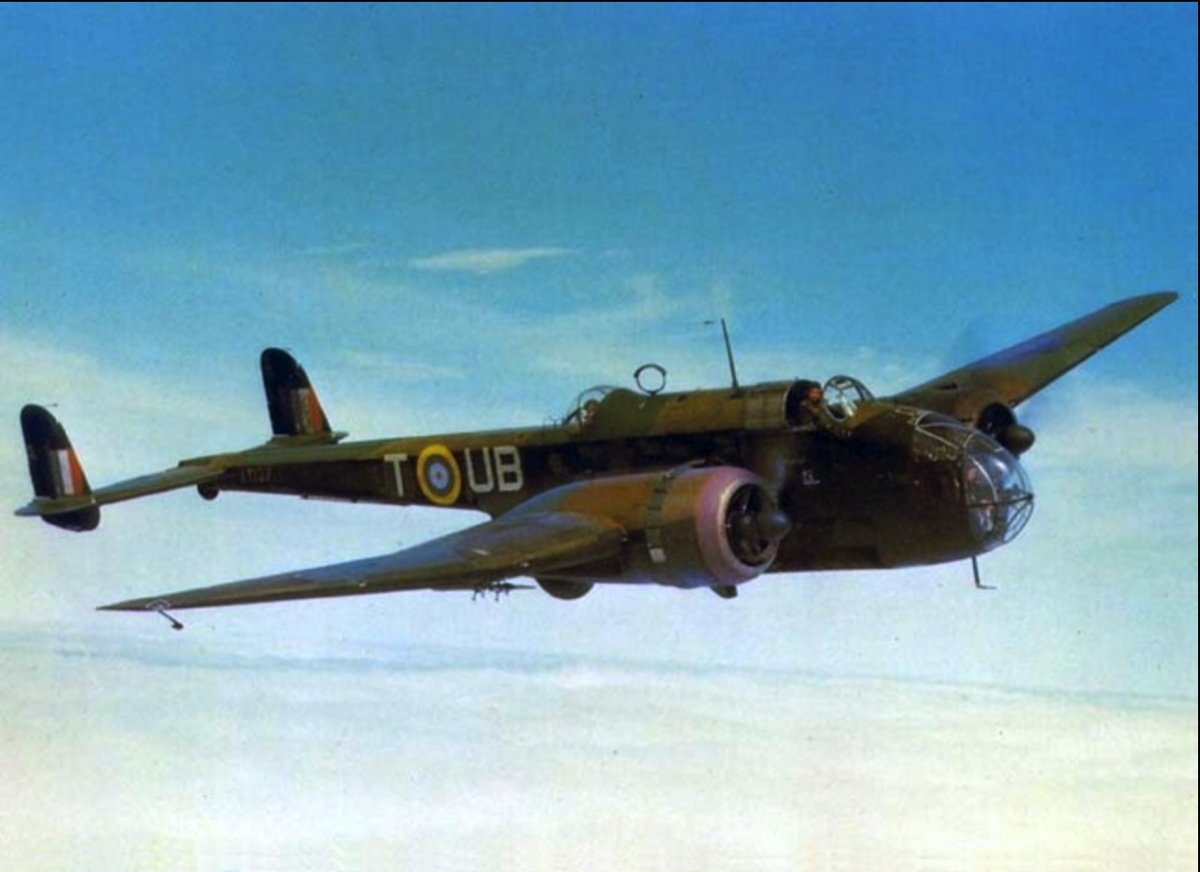
Handley Page Hampden.
Shot down by mistake, 21 December 1939
The Handley Page Hampden was a British medium bomber which first flew in 1936 and which was flown by ten squadrons at the start of the war in 1939. While manoeuvrable and relatively fast, it was soon outgunned by Luftwaffe fighters and quickly moved from operational to obsolete and was withdrawn from Bomber Command service by late 1942. The aircraft wasn't much beloved by aircrew being narrow and very cramped: it was often nicknamed 'The Flying suitcase'. However, it did form a significant element in the RAF's inventory at the outbreak of war alongside the more successful Wellington and the unweildy Whitley.
For some years now quite a few people have been keenly researching East Lothian wartime aircraft wrecks. The Air Crash Investigation and Archaeology group has a proud record in locating and researching such wartime crash sites. Thanks to them and, in this case to Scott McIntosh in particular, they have cast light on the fate of two Hampdens, L4089 and L4090 of 44 (Rhodesia) Squadron on the 21 December, 1939. Other local residents like Glenda Linton have been generous in sharing information about this incident with me and It is thanks to all of them that we now have this story to tell.
It is worth pointing out at this stage that aircraft recognition at this early stage in the war was pretty amateur and even those who flew in the RAF were sometimes guilty of getting it wrong. This was one of those occasions.
We are grateful to Wing Commander Mel James OBE for this contribution outlining what happened. By coincidence WC James's late father-in-law, Lt Cmdr Eric Monk DFM, a former Royal Navy pilot, was stationed at Drem as OC 736 (B) Sqn when the German delegation from Norway flew in to arrange the surrender of German forces there. He wrote:
"On 21st December 1939, twenty-four Handley Page Hampdens from three squadrons operating the aircraft from Lincolnshire airfields were tasked with bombing and mining German Navy ships , including the battleship Deutschland, off the Norway coast. This was a continual tasking requirement, the ability to engage the enemy depending largely on weather conditions at that time of the year.
Following the attacks on the German fleet, the aircraft were tasked with returning to RAF Lossiemouth on the Moray coast. For the purpose of defending the UK, this provided a large North Sea area free of RAF aircraft [I.e. free of any RAF fighter interception]. However, two of the Hampden crews from 44 Squadron opted to return to RAF Leuchars in Fife, much further south than Lossiemouth. Both aircraft were intercepted at about 1530 hours and were shot down by Spitfires from 602 (City of Glasgow) Squadron operating from RAF Drem in East Lothian. The aircraft were no doubt disabled by loss of engine power but both crews were able to attempt ditching in the North Sea.
One of the Spitfire pilots was Archibald McKellar, who successfully intercepted and shot down several German aircraft over the North Sea, but who was later killed in action on 1st November 1940.
… Hampden L4090 ditched in deep water off North Berwick. Three of the crew (Plt Off Dingwall, Sgt Reid and Sgt Lodge) were uninjured and were picked up by a fishing boat. The fourth crew member, W/O Leading Aircraftman Gibbin, probably located around the centre of the fuselage, drowned before the fishing boat crew were able to lift him free of the aircraft. L4090 subsequently sank.
…The crew of Hampden L4089 were much more fortunate. All crew members (Flg Off Sansom, Sgt Farrands, Sgt Boyle and Aircraftman First Class Little) were uninjured and walked away from their ditched aircraft."
For some years now quite a few people have been keenly researching East Lothian wartime aircraft wrecks. The Air Crash Investigation and Archaeology group has a proud record in locating and researching such wartime crash sites. Thanks to them and, in this case to Scott McIntosh in particular, they have cast light on the fate of two Hampdens, L4089 and L4090 of 44 (Rhodesia) Squadron on the 21 December, 1939. Other local residents like Glenda Linton have been generous in sharing information about this incident with me and It is thanks to all of them that we now have this story to tell.
It is worth pointing out at this stage that aircraft recognition at this early stage in the war was pretty amateur and even those who flew in the RAF were sometimes guilty of getting it wrong. This was one of those occasions.
We are grateful to Wing Commander Mel James OBE for this contribution outlining what happened. By coincidence WC James's late father-in-law, Lt Cmdr Eric Monk DFM, a former Royal Navy pilot, was stationed at Drem as OC 736 (B) Sqn when the German delegation from Norway flew in to arrange the surrender of German forces there. He wrote:
"On 21st December 1939, twenty-four Handley Page Hampdens from three squadrons operating the aircraft from Lincolnshire airfields were tasked with bombing and mining German Navy ships , including the battleship Deutschland, off the Norway coast. This was a continual tasking requirement, the ability to engage the enemy depending largely on weather conditions at that time of the year.
Following the attacks on the German fleet, the aircraft were tasked with returning to RAF Lossiemouth on the Moray coast. For the purpose of defending the UK, this provided a large North Sea area free of RAF aircraft [I.e. free of any RAF fighter interception]. However, two of the Hampden crews from 44 Squadron opted to return to RAF Leuchars in Fife, much further south than Lossiemouth. Both aircraft were intercepted at about 1530 hours and were shot down by Spitfires from 602 (City of Glasgow) Squadron operating from RAF Drem in East Lothian. The aircraft were no doubt disabled by loss of engine power but both crews were able to attempt ditching in the North Sea.
One of the Spitfire pilots was Archibald McKellar, who successfully intercepted and shot down several German aircraft over the North Sea, but who was later killed in action on 1st November 1940.
… Hampden L4090 ditched in deep water off North Berwick. Three of the crew (Plt Off Dingwall, Sgt Reid and Sgt Lodge) were uninjured and were picked up by a fishing boat. The fourth crew member, W/O Leading Aircraftman Gibbin, probably located around the centre of the fuselage, drowned before the fishing boat crew were able to lift him free of the aircraft. L4090 subsequently sank.
…The crew of Hampden L4089 were much more fortunate. All crew members (Flg Off Sansom, Sgt Farrands, Sgt Boyle and Aircraftman First Class Little) were uninjured and walked away from their ditched aircraft."
Confusions
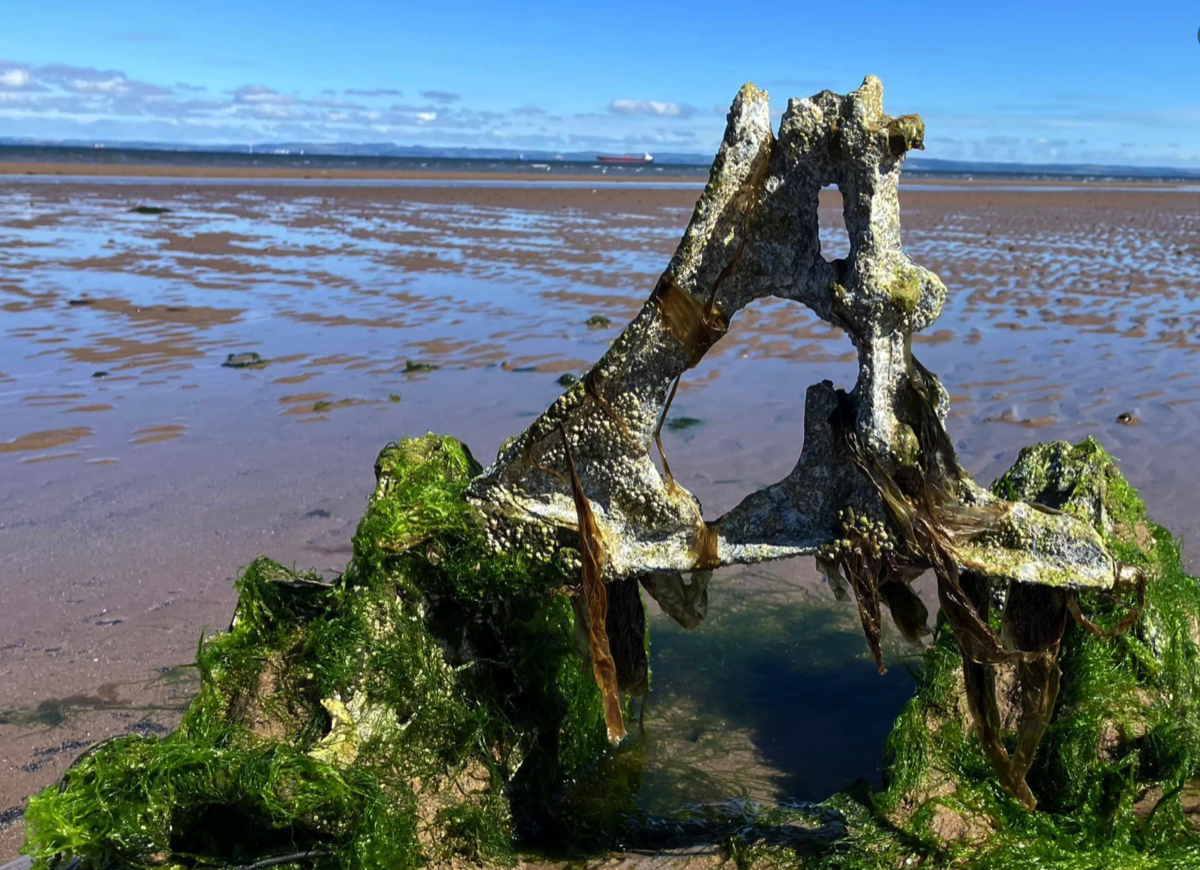
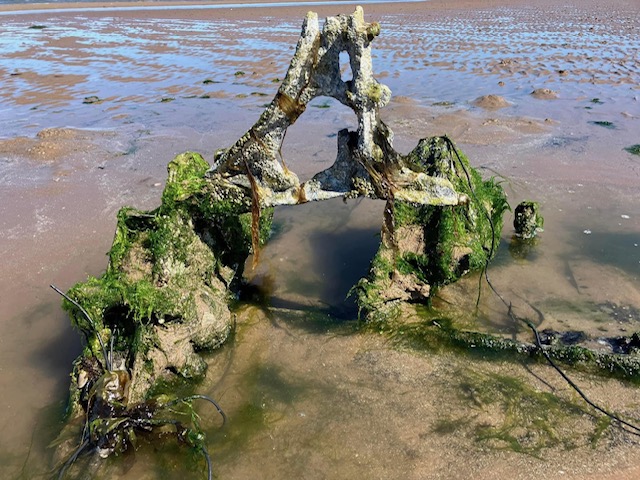
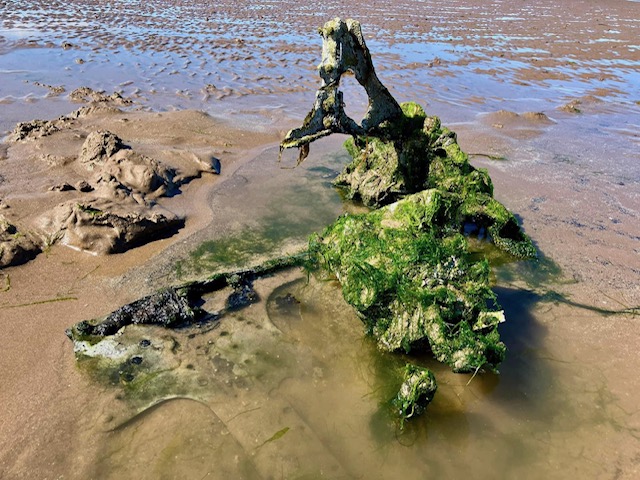
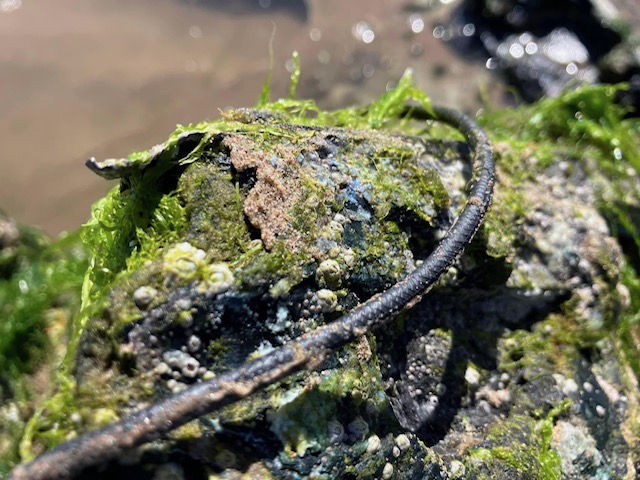
Four photographs taken of the remains of the Hampden's undercarriage struts and a length of cable.
[All courtesy of Glenda Linton]
Several confusions lie embedded this incident. HES Records have most likely confused L4089 with L4090 in placing the former's wreck off North Berwick. It is much more likely that what is left of L4089 lies in Aberlady Bay. The more creditable story is that L4089 ditched in Aberlady Bay at high tide but its remains were salvaged. As WC Mel James explains: "All crew members… were uninjured and walked away from the ditched aircraft. It is therefore highly likely that the bulk of the airframe and wings remained intact and in very shallow water, or indeed at the point of impact on wet sand. The absence of any major structural items or engines at the final resting place of the aircraft suggests that the aircraft was probably recovered for repair by an RAF 'crash and smash' team from the nearest Maintenance Unit and transferred to a Hampden Operational Training Unit for spare parts recovery. Whilst the three bladed De Havilland propellors would have been a write off (and removed as scrap), the Bristol Pegasus XVIII engines would have been worth saving in 1939, as would the airframe and wings.:"
Confusion, of course, lies at the very heart of this incident as this was a case of the RAF shooting down two of its own aircraft. Why did this happen? Some make the case that the Hampdens bore a superficial resemblance to Me 110s but their camouflage colours were different and Me 110s were not known to operate in this area at this stage of the war. A detailed eye-witness account of the shooting down of L4089 raises rather different points.
Confusion, of course, lies at the very heart of this incident as this was a case of the RAF shooting down two of its own aircraft. Why did this happen? Some make the case that the Hampdens bore a superficial resemblance to Me 110s but their camouflage colours were different and Me 110s were not known to operate in this area at this stage of the war. A detailed eye-witness account of the shooting down of L4089 raises rather different points.
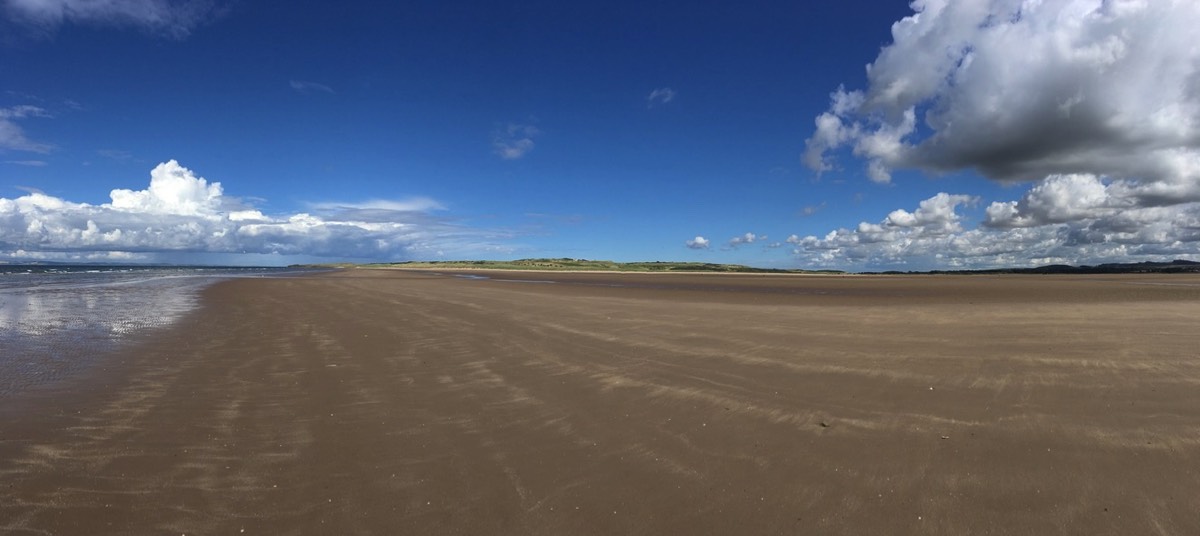
Aberlady Bay - the general area where L4089 crash landed.
[©️David Haire]
Sergeant Moyle, Observer, left a description of his experiences and this has been included in the book 'The King's Thunderbolts', written and compiled by Alan White. Sgt Moyle was most likely aboard Hampden L4089 which, we believe, crash landed in Aberlady Bay. His description would fit the case if the tide were in. The description answers a number of puzzling features of this incident but raises one which we will never know an answer to.
“The return leg across the sea was made in strong gusty winds and low cloud that frequently forced the aircraft down to 1,000 ft. As a result, wireless identification signals were not received by the RAF fighter defence system and the bomber formation made landfall some 100 miles south of the planned track. No 44 Squadron turned north and headed for Leuchars while the rest of the force turned south for Acklington.
It was now about 1500 hrs and we had been airborne for over seven hours. Since our duration was reckoned, with luck, to be about eight hours we were getting a little anxious about fuel. With about half an hour flying time left, formation flying was abandoned and the crews spread out to make the best use of their fuel. We pressed on northwards, heading for Leuchars which meant that we would cross the mouth of the Firth of Forth. Unbeknown to the crews, the fighter ground control had scrambled fighters to investigate.
I was suffering stomach cramp, having occupied the lower gun position for some seven hours, and asked if I could come up and sit on the lower wing root just behind the pilot. My forward view was obstructed by the armour plate extension to the pilot's seat so I asked if I might lower this and did so. I also opened the astro hatch doors in the roof and settled back to admire the scenery.
Fighters were in evidence and we expected to be subject to the usual exhibition flying if we met up with any, for they had a great affection for affiliation exercises. Consequently when I saw three Spitfires come tearing past and then turn to come in again from line astern, I expected a smart in and out which was usually most impressive. The three Spitfires came in from astern and just sat on our tail, the nearest being about twenty yards away.
I gave a friendly wave or two out of the astro hatch and the first Spit dived away but the other two stayed put and my repeated friendly waves had no effect. This was certainly not the usual run of things. I thought some positive proof of identity would be a good idea and made signs to the pilot that I would like to use the Verey pistol which was stowed by his right hand.
In this position it was fired downwards through a tube. As he was taking it out there was a noise similar to someone emptying a tin of nails onto a corrugated tin roof. My immediate reaction was to put as much aeroplane as possible between myself and those bullets, which could be seen as wisps of smoke in the cockpit as tracer and incendiaries whipped into the fuselage.
The ammunition in this first attack, amounting to some 2,000 rounds, was fired in three long bursts, after which the second aircraft took over. George pulled back the stick and we climbed while the Spit put in short bursts. He stalled away very shortly afterwards and we followed suit, entering a dive with blue smoke pouring from both engines. Realising that George might have bought it, I scrambled back onto the wing root, to see him slumped over the controls. I reached over to grab the control column and with great relief saw George move and then give me a thumbs up. His face was covered in blood where he had been hit by fragments of the shattered windscreen but apparently he was still capable of flying the aircraft.
We continued our dive towards the sea and it was obvious that we were going to have to ditch into a very nasty looking sea out of which the occasional bit of rock was visible. Thoughts about whether the bombs were still on board did cross my mind, as did baling out, but my parachute was still in the lower gun position, so that was out. Miraculously neither the wireless operator nor the navigator, a sergeant pilot, had been hit. He joined me on the wing root where, sitting back-to-back, we awaited our arrival on the sea.
We were braced for the impact which came as a fair old thump, but this turned out to be only the first bounce and when we hit the next time I finished up in a heap by the wireless operator's door. I could hear water pouring in.
In this position I realised that I was almost sitting on the emergency dinghy pack which I grabbed with the intention of pushing it out of the astro hatch. However, there was a problem, for the navigator was standing with one foot in the hatch and the other outside on the wing. I thumped his boot to attract his attention but the problem was soon resolved as the aircraft sank with me inside.
I pushed the dinghy out and went to follow but my parachute harness snagged in the downward folding door and I went with the aircraft down to the seabed. There I freed myself, for I didn't think of releasing my harness, and swam towards the surface. The water was dark green becoming blue as I neared the surface. By then I was almost unconscious but shouts from my three fellow crew members brought me back to reality. They were some distance away and there was no sign of the dinghy, which was probably full of holes anyway.
Our only means of survival was the Mae West and my pilot was shouting for me to blow it up since, in those days, there were no CO2 bottles and we had to inflate them ourselves. I did this until I became semi-conscious once again. The waves were lifting me up and down with the occasional wave breaking right over me.
I was already half asleep but had no fear of dying or experiencing any flashback of my life - all eighteen years of it; my only thought was that it was rotten luck on my Mum to be getting that telegram a couple of days before Christmas. I was really resigned to the fact that I had had my lot. There just didn't seem to be any way out, and I certainly was in no shape to last out the night in that water.
Suddenly, there was a sound above the waves; the throbbing of an engine and then, on top of a wave, a fishing boat appeared. In no time I had grabbed a rope and been hauled on board. There followed just one more anxious moment when one of my rescuers came at me knife in hand and made for my throat, but only to cut away my collar which might have strangled me had it shrunk. The boat was manned by the Pearsons, and landed us at North Berwick, where our arrival caused quite a stir particularly when the locals realised that we were 'RAF boys'.
We were bundled into a laundry van and whisked off to a nearby nursing home. There we stripped, draped ourselves in bath towels and were plied with Brandy. We sat in front of an old-fashioned kitchen range until an RAF ambulance arrived to take us to the Sick Quarters at Drem, the nearby RAF airfield and, incidentally, the lair of our assailants No602 (F) Sqn. The remaining aircraft had also landed there so our arrival was greeted by quite a reception committee, including Squadron Leader Watts who thought it was good experience' for us.
We soon had a bath were inspected and pronounced fit enough to go to the Sergeants' Mess where we were offered eggs on fried bread, ugh! Further liberal doses of whisky and beer resulted in intoxication and regurgitation which, in this position, probably didn't do us any harm at all!
A commendable emergency effort was then made to get the crew back to Lincoln for some unexpected Christmas leave, although there was a school of thought that it would be a good idea if we were not available to give evidence at the Court of Inquiry! In the event, we finally returned to Waddington without any problem and had our leave.
Unfortunately ours was not the only casualty. The Spitfires had also engaged another of the Squadron's Hampdens and it had also been ditched. Sadly, LAC Tich Gibbin was killed as he attempted to bail out and Sgt Lodge was struck on the head. He recovered but lost the sight in one eye as a result of it being damaged by incendiary material.” 1
So, if, as Sgt Boyle wrote, at least one of the Spitfires came to within twenty yards of the Hampden, why didn't the pilot recognise the plane as British? Even allowing for Sgt Boyle miscalculating the actual distance, the Spitfire must have been pretty close to the Hampden. At this early stage of the war one can believe that aircraft recognition wasn't as good as it later became but not to see the RAF roundels, not to recognise a known British type and not to see the 'friendly' waves, all adds up to an unusual compilation of errors. It wasn't 602 Squadron's finest moment but it certainly leaves us with some unanswerable questions.
1 My grateful thanks to Alan White, author and compiler of 'The King's Thunderbolts: No.44. (Rhodesia) Squadron RAF', for permission to re-publish this account and to Philip Leckenby MBE for his part in facilitating this long quotation.
“The return leg across the sea was made in strong gusty winds and low cloud that frequently forced the aircraft down to 1,000 ft. As a result, wireless identification signals were not received by the RAF fighter defence system and the bomber formation made landfall some 100 miles south of the planned track. No 44 Squadron turned north and headed for Leuchars while the rest of the force turned south for Acklington.
It was now about 1500 hrs and we had been airborne for over seven hours. Since our duration was reckoned, with luck, to be about eight hours we were getting a little anxious about fuel. With about half an hour flying time left, formation flying was abandoned and the crews spread out to make the best use of their fuel. We pressed on northwards, heading for Leuchars which meant that we would cross the mouth of the Firth of Forth. Unbeknown to the crews, the fighter ground control had scrambled fighters to investigate.
I was suffering stomach cramp, having occupied the lower gun position for some seven hours, and asked if I could come up and sit on the lower wing root just behind the pilot. My forward view was obstructed by the armour plate extension to the pilot's seat so I asked if I might lower this and did so. I also opened the astro hatch doors in the roof and settled back to admire the scenery.
Fighters were in evidence and we expected to be subject to the usual exhibition flying if we met up with any, for they had a great affection for affiliation exercises. Consequently when I saw three Spitfires come tearing past and then turn to come in again from line astern, I expected a smart in and out which was usually most impressive. The three Spitfires came in from astern and just sat on our tail, the nearest being about twenty yards away.
I gave a friendly wave or two out of the astro hatch and the first Spit dived away but the other two stayed put and my repeated friendly waves had no effect. This was certainly not the usual run of things. I thought some positive proof of identity would be a good idea and made signs to the pilot that I would like to use the Verey pistol which was stowed by his right hand.
In this position it was fired downwards through a tube. As he was taking it out there was a noise similar to someone emptying a tin of nails onto a corrugated tin roof. My immediate reaction was to put as much aeroplane as possible between myself and those bullets, which could be seen as wisps of smoke in the cockpit as tracer and incendiaries whipped into the fuselage.
The ammunition in this first attack, amounting to some 2,000 rounds, was fired in three long bursts, after which the second aircraft took over. George pulled back the stick and we climbed while the Spit put in short bursts. He stalled away very shortly afterwards and we followed suit, entering a dive with blue smoke pouring from both engines. Realising that George might have bought it, I scrambled back onto the wing root, to see him slumped over the controls. I reached over to grab the control column and with great relief saw George move and then give me a thumbs up. His face was covered in blood where he had been hit by fragments of the shattered windscreen but apparently he was still capable of flying the aircraft.
We continued our dive towards the sea and it was obvious that we were going to have to ditch into a very nasty looking sea out of which the occasional bit of rock was visible. Thoughts about whether the bombs were still on board did cross my mind, as did baling out, but my parachute was still in the lower gun position, so that was out. Miraculously neither the wireless operator nor the navigator, a sergeant pilot, had been hit. He joined me on the wing root where, sitting back-to-back, we awaited our arrival on the sea.
We were braced for the impact which came as a fair old thump, but this turned out to be only the first bounce and when we hit the next time I finished up in a heap by the wireless operator's door. I could hear water pouring in.
In this position I realised that I was almost sitting on the emergency dinghy pack which I grabbed with the intention of pushing it out of the astro hatch. However, there was a problem, for the navigator was standing with one foot in the hatch and the other outside on the wing. I thumped his boot to attract his attention but the problem was soon resolved as the aircraft sank with me inside.
I pushed the dinghy out and went to follow but my parachute harness snagged in the downward folding door and I went with the aircraft down to the seabed. There I freed myself, for I didn't think of releasing my harness, and swam towards the surface. The water was dark green becoming blue as I neared the surface. By then I was almost unconscious but shouts from my three fellow crew members brought me back to reality. They were some distance away and there was no sign of the dinghy, which was probably full of holes anyway.
Our only means of survival was the Mae West and my pilot was shouting for me to blow it up since, in those days, there were no CO2 bottles and we had to inflate them ourselves. I did this until I became semi-conscious once again. The waves were lifting me up and down with the occasional wave breaking right over me.
I was already half asleep but had no fear of dying or experiencing any flashback of my life - all eighteen years of it; my only thought was that it was rotten luck on my Mum to be getting that telegram a couple of days before Christmas. I was really resigned to the fact that I had had my lot. There just didn't seem to be any way out, and I certainly was in no shape to last out the night in that water.
Suddenly, there was a sound above the waves; the throbbing of an engine and then, on top of a wave, a fishing boat appeared. In no time I had grabbed a rope and been hauled on board. There followed just one more anxious moment when one of my rescuers came at me knife in hand and made for my throat, but only to cut away my collar which might have strangled me had it shrunk. The boat was manned by the Pearsons, and landed us at North Berwick, where our arrival caused quite a stir particularly when the locals realised that we were 'RAF boys'.
We were bundled into a laundry van and whisked off to a nearby nursing home. There we stripped, draped ourselves in bath towels and were plied with Brandy. We sat in front of an old-fashioned kitchen range until an RAF ambulance arrived to take us to the Sick Quarters at Drem, the nearby RAF airfield and, incidentally, the lair of our assailants No602 (F) Sqn. The remaining aircraft had also landed there so our arrival was greeted by quite a reception committee, including Squadron Leader Watts who thought it was good experience' for us.
We soon had a bath were inspected and pronounced fit enough to go to the Sergeants' Mess where we were offered eggs on fried bread, ugh! Further liberal doses of whisky and beer resulted in intoxication and regurgitation which, in this position, probably didn't do us any harm at all!
A commendable emergency effort was then made to get the crew back to Lincoln for some unexpected Christmas leave, although there was a school of thought that it would be a good idea if we were not available to give evidence at the Court of Inquiry! In the event, we finally returned to Waddington without any problem and had our leave.
Unfortunately ours was not the only casualty. The Spitfires had also engaged another of the Squadron's Hampdens and it had also been ditched. Sadly, LAC Tich Gibbin was killed as he attempted to bail out and Sgt Lodge was struck on the head. He recovered but lost the sight in one eye as a result of it being damaged by incendiary material.” 1
So, if, as Sgt Boyle wrote, at least one of the Spitfires came to within twenty yards of the Hampden, why didn't the pilot recognise the plane as British? Even allowing for Sgt Boyle miscalculating the actual distance, the Spitfire must have been pretty close to the Hampden. At this early stage of the war one can believe that aircraft recognition wasn't as good as it later became but not to see the RAF roundels, not to recognise a known British type and not to see the 'friendly' waves, all adds up to an unusual compilation of errors. It wasn't 602 Squadron's finest moment but it certainly leaves us with some unanswerable questions.
1 My grateful thanks to Alan White, author and compiler of 'The King's Thunderbolts: No.44. (Rhodesia) Squadron RAF', for permission to re-publish this account and to Philip Leckenby MBE for his part in facilitating this long quotation.

